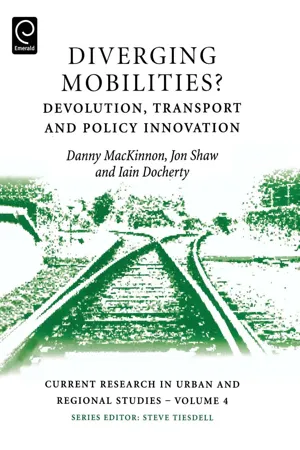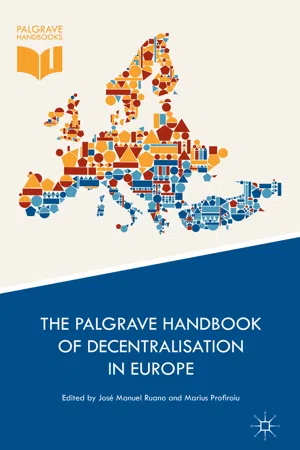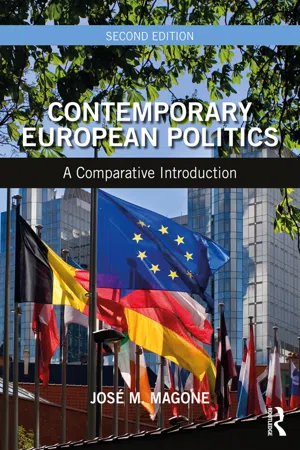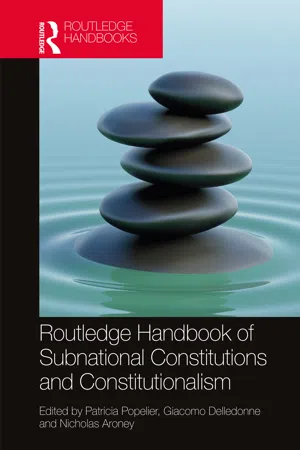Geography
Devolution in Belgium
Devolution in Belgium refers to the transfer of powers from the central government to regional authorities, particularly the Flemish, Walloon, and Brussels-Capital regions. This process has granted these regions significant autonomy in areas such as education, culture, and transportation. Devolution has been a response to the country's linguistic and cultural diversity, aiming to address regional disparities and promote local governance.
Written by Perlego with AI-assistance
Related key terms
1 of 5
7 Key excerpts on "Devolution in Belgium"
- No longer available |Learn more
Mind the Gap
Political Participation and Representation in Belgium
- Kris Deschouwer(Author)
- 2018(Publication Date)
- ECPR Press(Publisher)
Similarly, identity may structure preferences for more regionalisation. The appeasement of tensions between the Flemish and Walloon regions is another argument advanced for further regionalisation. The division of competences between the federal level and the regional and community levels is at the heart of proposed solutions to appease tensions between mainly the Flemish and Walloon regions in Belgium. Flanders and Wallonia have developed separate cultural and media landscapes and have separate party systems (Billiet, Maddens & Frognier 2006). Consequently, it is often argued that Belgian politics are dysfunctional because of irreconcilable attitudes and preferences on both sides of the language border. In Belgium, competences were initially (primarily) moved to pacify ideological and socio-economic conflict (Billiet, Maddens & Frognier 2006). Until the late 1950s, Belgian society was above all marked by deep cleavages between Catholics, socialists and liberals. Ideological divides were more salient than linguistic differences and also cross-cut the latter (Deschouwer 2006). Various consociational mechanisms appeased these conflicts in the late 1960s, opening up space for mobilisation along the linguistic divide, strongly linked to media, education and culture and above all to regional identity (Huyse 1971; Swenden & Jans 2006; Hooghe 2004). The legislative confirmation of official Dutch, French, German and bilingual language zones in the 1960s was – and remains – contentious, especially around Brussels – a ‘mainly French-speaking urban agglomeration surrounded by Dutch-speaking territory’ (Swenden & Jans 2006: 879). Territorial conflict between the Flemish and the Walloon regions thus essentially has linguistic roots (Hooghe 2004).Deschouwer et al. (2014) show that regional identity is significantly related to people’s views on granting power to the subnational level. Whereas overall support for regionalisation has decreased between 2009 and 2014 (which the authors interpret as an argument for the status quo eschewed from the Sixth State Reform), the study finds a link between Flemish identity and demands to move competences to the regions and communities. Those who identify more with Belgium, in turn, prefer to see competences moved to the federal level. However, no such relationship is found in Wallonia, possibly because of the weaker regionalist discourse that would politically mobilise Walloon identity (Deschouwer & Sinardet 2010). However, it remains unclear how this relationship between identity and competence distribution compares to other considerations and to other levels. To guide our test of identity-based mechanisms, the literature proposes that: - eBook - PDF
Diverging Mobilities
Devolution, Transport and Policy Innovation
- Danny MacKinnon, Jon Shaw, Iain Docherty, Danny MacKinnon, Jon Shaw, Iain Docherty, Steven Tiesdell(Authors)
- 2008(Publication Date)
- Elsevier Science Ltd(Publisher)
Despite this widespread experience of devolution, however, the UK debate has remained parochial, paying little attention to the wider international dimension ( Giordano & Roller, 2004 ; Mitchell, 2002 ). The experiences of states such as France and Spain which introduced decentralisation initiatives in the 1970s and 1980s against a tradition of centralised rule and in a context of European integration are particularly relevant ( Evans & Harding, 1997 ; Giordano & Roller, 2004 ), as is Canada’s struggle to recognise the demands of Quebec within the existing federation ( Simeon, 2001 ). Devolution, Regional Nationalism and European Integration Devolution can be seen as part of a broader revival of ‘the local’ as a contradictory effect of globalisation ( Harvey, 1989 ; Swyngedouw, 1992 ). A key aspect of this has been the rise of regionalist and nationalist political movements demanding 22 Diverging Mobilities? Devolution, Transport and Policy Innovation more power for their particular territories ( Agnew, 2000 ). In Western Europe, in particular, two main waves of ‘bottom up’ regionalism are apparent ( Keating, 1998 ). The first concerns an upsurge of regional ‘neo-nationalism’ in the 1970s and 1980s which affected regions containing social groups who defined themselves as distinct from the wider population of the state and demanded greater autonomy or even separation on this basis ( Figure 2.2 ) ( Nairn, 1977 ; Rokkan & Urwin, 1983 ). Since the 0 km 300 0 miles 200 N BELGIUM NETHERLANDS A t l a n t i c O c e a n N o r t h S e a M e d i t e r r a n e a n S e a F R A N C E S P A I N I T A L Y U . K . IRISH REP. Scotland Wales Northern Ireland Flanders Wallonia Brittany Alsace Corsica Occitanie Catalonia Basque Country Galicia Andalusia Fruili South Tyrol Sardinia Friesland G E R M A N Y 1 1 2 2 3 3 4 4 5 5 6 6 7 7 8 8 9 9 10 10 11 11 12 12 13 13 14 14 15 15 16 16 17 17 Figure 2.2: The resurgence of regional nationalism in Western Europe. - José Manuel Ruano, Marius Profiroiu, José Manuel Ruano, Marius Profiroiu(Authors)
- 2016(Publication Date)
- Palgrave Macmillan(Publisher)
47 © The Author(s) 2017 J.M. Ruano, M. Profiroiu (eds.), The Palgrave Handbook of Decentralisation in Europe, DOI 10.1007/978-3-319-32437-1_3 3 Federalism and Decentralisation in Belgium Jean-François Husson, Céline Mahieu, and Caroline Sägesser Recent History of the Decentralisation Process At the time of independence (1830), Belgium was a unitary state with nine provinces, roughly corresponding to the Départements established by the pre- vious French rulers, and 2739 municipalities ( communes). 1 Some cultural demands expressed in Flanders remained unmet. When it occupied Belgium in 1914–1918, Germany promoted a kind of regional policy and established a Flemish government, giving ground to some Flemish requests. Despite the resulting negative associated image, some Flemish requests were encountered in the interwar period, most notably by grant- ing a Flemish identity to the University of Ghent. The structure of the State remained globally unchanged until the 1960s, when “linguistic borders” were established, paving the way for a sort of regionalist and later federalist process. 1 This number was later reduced, some municipalities being lost to the Netherlands or the Grand-Duchy of Luxemburg in 1839, some being gained from Germany after WWI and some others being merged. J.-F. Husson () Université Catholique de Louvain (UCL), Louvain-la-Neuve, Belgium e-mail: [email protected] C. Mahieu Free University of Brussels (ULB), Brussels, Belgium C. Sägesser Centre de Recherche et d’Information Socio-Politique (CRISP), Brussels, Belgium Three trends then emerged; these were a Flemish demand for more cultural autonomy, a Walloon demand for more social and economic autonomy and a wish for some rationalisation of local government structure. These various moves concluded with a sequence of legal and constitutional reforms. Willingness to rationalise the municipal level motivated the first reforms.- eBook - ePub
Contemporary European Politics
A Comparative Introduction
- José M. Magone(Author)
- 2019(Publication Date)
- Routledge(Publisher)
Belgium is the youngest federal state in Europe. It was established after the ratification of the new constitution in 1993. This was the culmination of a process of decentralisation that had been taking place since the 1960s. Meanwhile there were six state reforms, the latest in 2014, which included a redesigning of the Senate as the chamber of the subnational units. At the centre was an ongoing latent conflict between the Francophone region of Wallonia and the Flemish-speaking region of Flanders. Although there is a third German linguistic group, in the east of Belgium, it has remained outside the major conflict between the two regions. Before the Second World War, when Wallonia dominated the unitary state, the Flemish-speaking population felt disadvantaged in Belgium. After the Second World War, Flanders gradually became the richest part of Belgium and began to demand greater autonomy. Moreover, the population ratio between the two parts of Belgium became inverted. Although before the Second World War, the majority of the population was living in Wallonia, in the 1960s there was a larger share of the population in Flanders. Since the 1960s, there has been a process of decentralisation and also some separation of the two populations (I would rather characterise this as ‘civilised ethnic cleansing’, pushed more by Flanders). Piecemeal reforms were undertaken so that greater autonomy could be granted to the three regions. However, this period was also characterised by many conflicts (Leton and Miroir, 1999). The new federal structure comprises six subnational units: three regions and three cultural communities. The three regions are Flanders, Wallonia and Brussels. and the cultural communities are the Flemish, Francophone and German communities. The Flemish region and community have merged and built one government. There are also attempts of coordination and even fusion, between the regional government of Wallonia and the Francophone community, but in terms of boundaries this is more difficult. One characteristic of Belgian politics is that there is no national party system. There are now two party systems, one in Wallonia and the other in Flanders, and, depending on the national strength of each party in each of the two regions, they then negotiate a coalition government at national level. Less known, is that there is a third party system in the German community. - eBook - ePub
The Second Tier of Local Government in Europe
Provinces, Counties, Départements and Landkreise in Comparison
- Hubert Heinelt, Xavier Bertrana(Authors)
- 2012(Publication Date)
- Routledge(Publisher)
Up to the start of the twenty-first century the basic features of provincial government were regulated by the provincial law of 1836. After the creation of the regions and communities, they have been attributed with a growing number of competences that used to belong to the federal government (Deschouwer 2009: 41–72). In 2001, most competences regarding the organisation of local government were transferred from the federal to the regional government level (Special Law 13 July 2001, see below). Since that time, the legal frameworks in the Flemish and Walloon regions have diverged. The Walloon decrees of 2002 and 2004 have reoriented the Walloon provinces, linking the provincial policy more closely with the policies of the regional government. Moreover they created a new balance between the various provincial actors, causing a shift in the relations between the council, the executive and the governor (see below). In Flanders, the institutional setup that already existed was not changed (the functions of the provincial actors remained more or less stable), but the Flemish Decree of 2005 focused on the introduction of elements of new public management and the orientation of provincial policy in a new threefold mission statement (Valcke and Reynaert 2007: 38–42). This mission identifies three tasks for the Flemish provinces: tasks at the supra-local level, supporting municipal government and the so-called area oriented tasks (limited to a specific area of the provincial territory).This leads some authors to state that the on-going process of federalisation has activated different local regimes in Flanders and Wallonia (Fornés 2005: 36; De Rynck and Wayenberg 2010). It can be argued that the regionalisation of competences has effectively given rise to divergent forms of local government in the two regions (Valcke 2009: 278–281).Over time, only small changes have been made to the boundaries of the provinces. Moreover, these changes have not affected the functioning of the provincial institution. The most extensive changes took place in 1963, when the linguistic border was fixed.2 These border changes between the provinces had nothing to do with provincial policies but were the result of political agreements between the two main communities in an attempt to pacify the cultural-linguistic cleavage that runs across the country.Although there are but ten Belgian provinces, they present many individual differences in terms of their geographic and socio-demographic characteristics, as Table 2.1 - Patricia Popelier, Giacomo Delledonne, Nicholas Aroney, Patricia Popelier, Giacomo Delledonne, Nicholas Aroney, Patricia Popelier, Nicholas Aroney, Giacomo Delledonne(Authors)
- 2021(Publication Date)
- Taylor & Francis(Publisher)
4 Federalism became the device for managing multinational conflicts.While multinationalism is at the foundation of the Belgian federalization process, at the same time it explains the reluctance to grant subnational constitutional autonomy. The reason is that federalism is a tool to facilitate co-existence within a multinational state, but also sows seeds for more radical autonomy claims, that may culminate in separatism. In Belgium, the Flemings push hard for more autonomy, whereas the Walloons, for economic reasons, remain more attached to the Belgian federal state. The Walloons therefore tend to interpret the Flemish claim for their own constitution as a sign of a hidden agenda of Flemish separatism. This is not far-fetched: institutional capacity appears to be one of the building blocks that facilitate separatism.5 Walloon distrust of the French-speaking parties explains why the constitutional autonomy of the SNEs has remained rather limited.6Dyadic. Although Belgium consists of six SNEs7 —three Communities and three Regions—Belgian federalism in fact revolves around the two major language groups. This is reflected in the institutional design of the constitution, with a French and a Dutch language group in the House of Representatives and the Senate; linguistic parity in the federal government; and linguistic parity in the composition of the apex courts. As a result, the federal decision-making process in Belgium shows confederal traits, as each language group has a de jure or de facto veto right.Dyadic federalism, however, is a conflictual and therefore unstable form of state.8 This adds to the atmosphere of distrust and ensures that the demand for subnational constitutional powers ends up part of a difficult negotiating package. Also, dyadic federalism explains why constitutional powers were granted to the Brussels Region with some delay. The reasons are that the Flemish minority in Brussels needs special protection,9 and that Flemish political parties feared that the strengthening of the Brussels Region, which is officially bilingual but predominantly French-speaking in fact, would lead to francophone dominance in the overall federal system.10- eBook - PDF
Indonesia Today
Challenges of History
- Shannon L. Smith, Grayson J. Lloyd(Authors)
- 2001(Publication Date)
- ISEAS Publishing(Publisher)
After a brief discussion of the various forms of regional autonomy and decentralisation, we summarise the features of each main phase in the evolution of centre–region relations, and then examine the fiscal aspects of regional autonomy . 17 THE LATEST CRISIS OF REGIONAL AUTONOMY IN HISTORICAL PERSPECTIVE Wihana Kirana Jaya and Howard Dick 216 REGIONAL AUTONOMY AND DECENTRALISATION Fundamental to the study of regional autonomy is the issue of political power. Centre–region relations are concerned with the distribution of power between levels of government (Davey 1989). This division of power arises in any democratic system, unitary or federal (Zariski and Rousseau 1987). One form of decentralisation is federalism, in which the constitution divides power between national and local levels of government and in which each level of authority retains some exclusive powers. Another form is regional devolution, in which national power is paramount over regional powers and in which a central government agent can appeal against regional legislation. Decentralisation theory recognises four types of decentralisation: political, administrative, fiscal and market (Rondinnelli 1999). This chapter will focus on the first three of these. Political decentralisation is the mechanism by which the central government transfers political power to local governments. Administrative decentralisation is the delegation of administrative authority from central to local government. Its three forms are de-concentration, dele- gation and devolution. De-concentration exists when the central government disperses responsibility for the delivery of services to the local level; delega- tion and devolution relate to the balancing of central and local interests. Fis- cal decentralisation essentially involves increasing the financial responsibility of local government. A review of decentralisation literature suggests several criteria for achieving decentralisation (Litvack and Seddon 1999).
Index pages curate the most relevant extracts from our library of academic textbooks. They’ve been created using an in-house natural language model (NLM), each adding context and meaning to key research topics.






